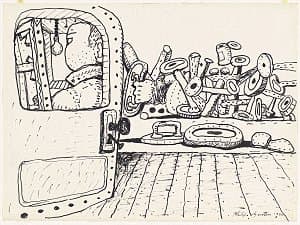

Philip Guston
Learn moreKey 1980
Purchased 1980
More detail | PermalinkPhillip Guston’s later work exposes his private world, a solitary existence in his studio at Woodstock, New York, to the wider social and political events impacting upon America through the 1960s and 70s. As Guston conceded:
So when the 1960s came along I was feeling split, schizophrenic. The war, what was happening to America, the brutality of the world. What kind of man am I, sitting at home, reading magazines, going into a frustrated fury about everything―and then going into my studio to adjust a red to a blue … I thought there must be some way I could do something about it.[i]
Key 1980, made in the months before his death from a heart attack, captures some of this sentiment: the painter works on a canvas with his back turned on a scene of jumbled, degraded humanity. Key employs similar iconography to Pit 1976 and other works of this period, in the hellish piles of rubbish and disembodied limbs, and shares an ambiguity that defies attempts to pin down a clear interpretation of the composition.
Both Pit and Key seem to reject many of the tenets underpinning Guston’s Abstract Expressionist work of the 1950s as well as the rhetoric surrounding Modernism. By acknowledging that the artist is tied to, and therefore must engage with, the wider community, Guston vindicates the radical shift of his work and the incisive social commentary that surfaces in his late figurative paintings.
Michael Lloyd and Michael Desmond[ii]
[i] Philip Guston, quoted in Jerry Talmer, ‘”Creation” is for beauty parlors’, New York Post, 9 April 1977, reproduced in Robert Storr, Philip Guston, Abbeville Press, New York, 1986, p 53.
[ii] Adapted and updated from Michael Lloyd and Michael Desmond, European and American Paintings and Sculptures 1870–1970 in the Australian National Gallery, Australian National Gallery, Canberra, 1992 by Steven Tonkin.

